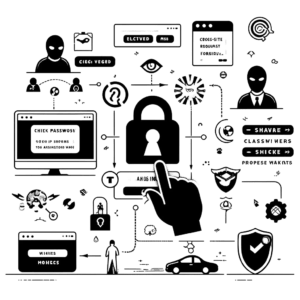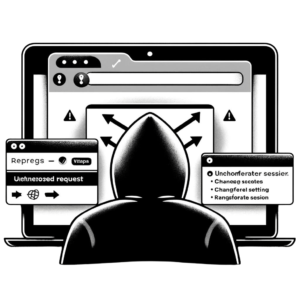Understanding CSRF Attacks
Cross-Site Request Forgery, or CSRF for short, is a type of web vulnerability where a bad website can trick your internet browser into taking actions on a different secure site without your knowledge or permission. This happens because the secure site trusts your browser. It can lead to several security concerns.
To protect against this attack, it’s important to have strong security in place. One way to do this is by using CSRF tokens, which are special codes created by the server and included with each request. These tokens help to confirm that the request is genuine and not from a harmful external site.
Additionally, developers should avoid using predictable URLs for sensitive operations and ensure that all critical actions require user authentication. It is also crucial to regularly update and patch web applications to address any known vulnerabilities that may be exploited by CSRF attacks.
By learning how these attacks happen and using strong security measures, companies can keep their systems and data safe from hacks and unauthorized entry.
The Potential Risks of CSRF
Cross-Site Request Forgery is a type of cyber attack where someone tricks a website into thinking a trusted user is making a request, when in reality the request is harmful. This can be really dangerous for both users and organizations. For example, hackers could secretly transfer money from a user’s account to their own, causing financial harm to the user and damage to the reputation of the website.
One major concern with it is that it can put your personal information at risk. Hackers could use this vulnerability to sneak into your accounts and steal sensitive data like your passwords, credit card numbers, and other private details. This could result in identity theft, fraud, and other types of online crimes.
In order to stay safe online, it’s important for companies to put measures in place to protect against Cross-Site Request Forgery attacks. This includes using things like CSRF tokens, enforcing same-origin policy, and keeping security software up to date. By being aware of the risks and taking steps to prevent them, both users and organizations can improve their online safety and reduce the chances of being targeted by hackers.
The Process of CSRF Attacks
When it comes to cybersecurity threats, CSRF vulnerability is a serious concern for individuals and organizations alike. CSRF attacks involve exploiting the trust that a website has in a user’s browser to carry out malicious actions without the user’s consent. The process of an attack typically involves tricking a user into unknowingly sending a request to a website that they are authenticated with, allowing the attacker to perform actions on their behalf.
One common example of an attack is when a user is logged into their online banking account and clicks on a malicious link that initiates a transfer of funds without their knowledge. The user’s browser sends the request to the banking website, authenticating the request as if it came directly from the user.
In order to protect websites from a type of cyber attack called CSRF, it’s important for them to put in place security measures like using anti-CSRF tokens, checking requests to make sure they’re valid, and setting strict access controls. By learning how the attacks work, people and businesses can better safeguard themselves against these damaging online threats.
Examples of CSRF Attacks
Cross-Site Request Forgery is a common security issue on websites that allows bad actors to manipulate users into performing actions on sites they are logged into. For example, an attacker might send a harmful link to a user via email or social media. If the user clicks the link while logged into a website, the attacker can use the user’s authorization to do things like change passwords, make purchases, or take control of the account without the user even knowing.
Another example is when hackers take advantage of weaknesses in online forms that do not have proper security measures in place. They can trick websites into thinking their requests are legitimate, causing actions to be taken on the user’s behalf without them even knowing. This can lead to theft of personal information, money, and reputation damage for both individuals and companies.
To avoid CSRF attacks, website developers should take steps like using CSRF tokens, checking servers for suspicious activity, and using SameSite cookies to confirm requests are coming from reliable sources. 
Preventive Measures
Cross-Site Request Forgery is a sneaky way that hackers try to get users to do things on a website that they didn’t mean to. Basically, a user might click on a link that looks normal, but behind the scenes, it actually does something bad without the user realizing it.
To protect against CSRF, there are ways to improve security. One method is to use CSRF tokens. These tokens are unique codes created by the server and added to each request. When a request is sent to the server, it checks to make sure the CSRF token is included and correct, which helps verify that the request is legitimate.
Another important practice is to utilize the SameSite attribute in cookies, which restricts the browser from sending cookies in cross-origin requests. This helps prevent attacks by ensuring that cookies are only sent to the same domain that set them.
Implementing strict input validation, employing the use of HTTP headers such as X-Frame-Options and Content Security Policy, and regularly updating and patching web applications are also crucial security practices to defend against attacks.
How to Detect CSRF Vulnerabilities
Tools and Techniques for Detection
When it comes to combating CSRF, having the right tools and techniques for detection is crucial. One effective tool is utilizing web application firewalls (WAFs) that can help detect and prevent attacks by monitoring and filtering HTTP requests. Additionally, implementing strict validation checks for user input and utilizing randomly generated tokens can help thwart potential attacks.
Another useful method for spotting CSRF attacks is by using SameSite cookies. These cookies limit the sharing of information between different websites, making it harder for attackers to exploit vulnerabilities. It’s also a good idea to regularly check your website’s security through audits and penetration testing. This can help uncover any weaknesses that could be exploited by CSRF attacks.
To protect yourself from dangerous attacks online, it’s important to be cautious and use a variety of tools like firewalls, security checks, random codes, special cookies, and regular security checks. These measures can help strengthen your defense against a common threat known as CSRF and reduce the chances of being harmed by it.
Penetration Testing for CSRF
Testing for Cross-Site Request Forgery is important for keeping web applications safe. Attacks happen when someone carries out unauthorized actions on a website using a person’s account without their permission. By doing specialized testing to find and fix these vulnerabilities, companies can stop hackers from taking advantage of weaknesses and making unauthorized changes.
In penetration testing, security experts imitate real-life cyber attacks to test how well a website’s security measures work and find any weaknesses. By studying how the website reacts to different types of attacks, the experts can suggest ways to fix any vulnerabilities and prevent CSRF attacks from happening.
Effective measures to stop CSRF attacks include implementing anti-CSRF tokens, validating and sanitizing user input, and enforcing strict access controls. Regular penetration testing for CSRF ensures that these preventive measures are robust and up-to-date, helping organizations stay ahead of evolving cybersecurity threats.
Conclusion
When it comes to keeping your organization safe on the internet, it’s important to be cautious. One common threat to your system’s security is something called Cross-Site Request Forgery. This is a sneaky attack where bad actors trick a website into thinking they’re a trusted user, which can lead to things like stealing money or changing settings without permission. It’s a serious problem that can cause major issues if you’re not careful.
To prevent these attacks, it is crucial to implement security measures such as using anti-CSRF tokens, which are unique tokens generated for each user session. These tokens help verify that the requests coming to the server are from legitimate users and not from malicious attackers. Additionally, ensuring that sensitive actions require user authentication can also help mitigate the risk of these attacks.
Keep learning about new cybersecurity threats and teach your team to do the same. Make sure you have strong security measures in place to protect against attacks. Stay alert and be proactive in staying safe in the always-changing world of cybersecurity.

